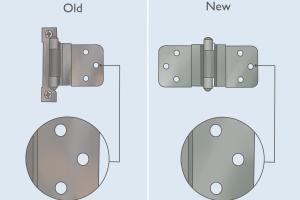Ultimate Guide to Measuring Cabinet Hinges: Tips, Tools, and Techniques

-
Quick Links:
- Introduction
- Understanding Cabinet Hinges
- Tools Required
- Step-by-Step Measuring Guide
- Common Measurement Errors
- Case Studies
- Expert Insights
- Conclusion
- FAQs
Introduction
Measuring cabinet hinges accurately is crucial for ensuring that your cabinet doors function smoothly and fit perfectly. Whether you are a DIY enthusiast or a professional woodworker, understanding how to measure cabinet hinges can save you time, money, and frustration. In this ultimate guide, we will delve into the intricacies of measuring cabinet hinges, providing you with practical tips, tools, and techniques to achieve precision.
Understanding Cabinet Hinges
Cabinet hinges come in various types and sizes, each designed for specific applications. Here's an overview of the most common types:
- Concealed Hinges: These hinges are hidden when the cabinet door is closed, offering a sleek look.
- Surface-Mounted Hinges: These are visible on the outside of the cabinet and are often more durable.
- European Hinges: A subtype of concealed hinges, these are popular in modern cabinetry.
- Pivot Hinges: These allow the door to pivot around a point, often used in corner cabinets.
Tools Required
Before measuring your cabinet hinges, gather the following tools:
- Measuring Tape
- Caliper (for precise measurements)
- Pencil and Paper (for notes)
- Ruler or Straightedge
- Level (for ensuring door alignment)
Step-by-Step Measuring Guide
Step 1: Determine the Type of Hinge
Identify the type of hinge you are measuring. This will dictate the measurements you need to take.
Step 2: Measure the Hinge Leaf Width
Using your measuring tape, measure the width of one hinge leaf from edge to edge. Record this measurement.
Step 3: Measure the Hinge Leaf Height
Next, measure the height of the hinge leaf. This is particularly important for concealed hinges.
Step 4: Check the Hinge Pivot Point
For pivot hinges, measure the distance from the pivot point to the edge of the cabinet door. This is crucial for alignment.
Step 5: Measure the Door Thickness
Measure the thickness of the cabinet door. This is essential for selecting the right hinge type.
Step 6: Record All Measurements
Ensure that all measurements are accurately recorded, as these will guide your hinge selection.
Common Measurement Errors
Even experienced professionals can make mistakes when measuring hinges. Here are some common errors to avoid:
- Not Measuring Twice: Always double-check your measurements to ensure accuracy.
- Assuming Standard Sizes: Hinges come in various sizes; never assume anything without measuring.
- Ignoring Door Weight: The weight of the cabinet door can affect hinge selection and placement.
Case Studies
To provide additional context, let’s explore a few case studies highlighting the importance of accurate hinge measurements:
Case Study 1: Kitchen Cabinet Renovation
In a recent kitchen renovation project, a homeowner measured their existing hinges but failed to account for the door thickness. As a result, they purchased hinges that were too large, leading to misalignment and additional costs.
Case Study 2: Custom Furniture Design
A furniture maker designed a custom cabinet but neglected to consider the weight of the doors. The selected hinges could not support the weight, resulting in a collapse. Accurate measurements would have prevented this costly mistake.
Expert Insights
We reached out to seasoned carpenters and cabinet makers for their insights on measuring cabinet hinges:
- John Smith, Master Carpenter: "Always measure twice and choose hinges that match the weight and style of your cabinet doors."
- Linda Johnson, Cabinet Maker: "Don't underestimate the importance of a good measuring tool. A caliper can save you from headaches down the line."
Conclusion
Measuring cabinet hinges may seem straightforward, but precision is key to a successful installation. By following the steps outlined in this guide and avoiding common pitfalls, you can ensure that your cabinet doors function perfectly. Remember, when in doubt, seek advice from a professional.
FAQs
1. What tools do I need to measure cabinet hinges?
You will need a measuring tape, caliper, pencil, paper, ruler, and possibly a level.
2. How do I know what type of hinge to use?
Consider the door style, weight, and whether you want visible or concealed hinges.
3. Can I use any hinge for my cabinet door?
Not all hinges are suitable for all cabinet doors. Ensure the hinge can support the door's weight and matches the style.
4. What are the most common mistakes when measuring hinges?
Common mistakes include not measuring twice, assuming standard sizes, and ignoring door weight.
5. How do I measure the thickness of a cabinet door?
Simply use a measuring tape or ruler to measure the door from front to back.
6. Are there standard measurements for cabinet hinges?
Hinge measurements vary by type and manufacturer. Always measure your hinges for accuracy.
7. How can I ensure my cabinet doors align properly?
Use a level during installation and check that your hinges are installed at the correct height and distance from the edges.
8. What if my measurements are slightly off?
Small discrepancies can sometimes be adjusted during installation, but it’s best to ensure accurate measurements from the start.
9. Can I install cabinet hinges myself?
Yes, with the right tools and measurements, you can install cabinet hinges yourself.
10. Where can I buy quality cabinet hinges?
Quality cabinet hinges can be found at local hardware stores or online retailers specializing in cabinet hardware.
Random Reads
- Remove ask toolbar chrome
- Remove background desktop windows
- How to remove a chuck from a drill
- How to remove a broken or snapped drill bit
- How to log in
- How to log in to a netgear router
- Mastering header rows excel
- Mastering if else excel guide
- How to transfer data between two hard drives
- How to see files in cmd